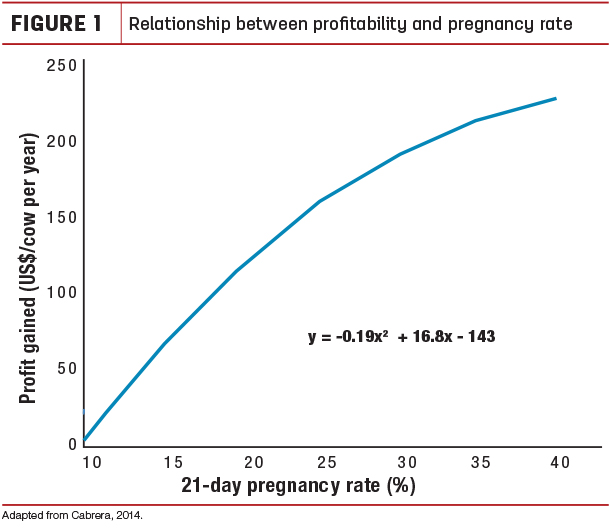Reproductive efficiency still matters, even when dollars are tight What happens when things start to get tight financially? Most of us would make a list of expenditures and prioritize what to cut back on or cut completely out.
-
Luxuries – Cable or Dish TV, eating out, mobile device expenditures
-
Secondary needs – Health care expenses, retirement contributions, savings
- Primary needs – Transportation, food and shelter
Even with primary needs, there are likely some opportunities for cost savings. Perhaps you avoid servicing vehicles and put off roof repairs on the house for several years. Which expenses should you cut? The important question to ask is: What unforeseen financial liabilities will these decisions have on your life, both short- and long-term?
When it comes to reproductive management of dairy cattle, the same approach applies. It is important to understand certain cost-reduction decisions could create more financial liabilities.
The purpose of reproductive management is to achieve an economically optimum time of conception for an animal. Reproductive efficiency is how well that goal is achieved and is commonly measured as pregnancy rate (per 21-day period). Pregnancy rate is controlled by:
-
Voluntary waiting period – Days post-fresh an animal is eligible for insemination
-
Submission rate – The likelihood the animal will be inseminated when eligible
- Conception rate – The likelihood an animal will conceive when inseminated
Costs directly related to reproductive management are considerably less than feed and labor costs, the greatest expenditures of a dairy. Estimating the economics of reproductive efficiency is complex and varies based on cost and revenue inputs unique to each dairy.
In general, costs associated with reproductive efficiency can be divided into direct and indirect costs. Direct costs, such as pharmaceuticals, technician service, semen cost, pregnancy diagnoses and so on, add up each time an animal fails to conceive and is submitted for another service; therefore, improved conception rates directly reduce these costs.
Indirect costs, the financial liabilities of pregnancy not occurring in a timely manner, are typically greater and less straightforward than direct costs or liabilities.
Most people are familiar with the cost of extra days open and the liability thereof, ranging from -$2 to -$5 per head per day depending on the source and data inputs. This metric is influenced primarily by indirect costs associated with milk production, milk price, feed costs, sale of animals and especially by culling and replacement actions and needs.
Researchers in 2017 provided a comprehensive look at the economics of reproductive efficiency. In general, profitability per cow increases as pregnancy rate increases (Figure 1).
 Consider that management decisions to reduce cost may affect reproductive efficiency and, consequently, decrease profitability. The pointers below, based on some examples reported from the field, speak to some opportunities or liabilities when making management decisions to reduce costs.
Consider that management decisions to reduce cost may affect reproductive efficiency and, consequently, decrease profitability. The pointers below, based on some examples reported from the field, speak to some opportunities or liabilities when making management decisions to reduce costs.
Be careful playing around with the ration. Feed is the greatest expense of a dairy. The TMR should be formulated to meet all macro- and micronutrient requirements of an animal based on their maintenance requirements and production needs. Deletion or substitution of ration ingredients may result in decreased conception rates.
During low milk prices 10 years ago, one of our customers completely removed the mineral premix from his TMR. Conception rate was reduced by 50 percent as a result. More recently, conception rate crashed when a customer substituted one feedstuff for an inexpensive and unusual feedstuff.
Cutting corners with nutrition may lead to a reduction in reproductive efficiency by reducing conception rate and, potentially, submission rate.
Don’t neglect your heifers. Most dairymen have plenty of heifers standing around, eating and waiting to become pregnant without generating any income until either entering the lactating herd or by sale. When times are tight, one might be tempted to divert resources away from heifers.
Nutritional neglect might occur by, but is not limited to, underfeeding, cutting or substituting feedstuffs as described above, feeding refusals from the lactating herd, all of which could result in reduced conception rates or delaying reproductive maturity.
Neglect might also occur in the timeliness that heifers are moved into the A.I. pen or other reasons for delay of insemination. Optimize pregnancy rate to hit a target of 23 to 24 months old at first calving.
Don’t be penny wise but pound foolish when it comes to purchasing semen. A straw of semen is relatively inexpensive compared to other costs of the dairy. Differences in semen cost among bulls are likely surpassed by the difference in value of genetics and fertility.
Purchasing semen from a reputable A.I. organization in addition to realistic use of sire fertility data can stack the odds of conception in your favor and increase reproductive efficiency. Remember, reducing the number of services per conception reduces the number of straws purchased.
Value of the pregnancy is another important aspect to consider. The genetic investments made today will be your herd replacements in three years. Are the extra dollars spent on semen today worth it? In general, the value of semen increases as sire genetic merit (NM$) and fertility (herd and sire) increases.
Make data-driven decisions and ask for help. There are many calculators available from academic and industry sources to estimate the costs associated with reproductive efficiency and the profitability thereof. Do not use the “standard” approximations for costs and revenue. Use your own data.
Calculators can range from simple to quite complex, and knowing what and where to find the appropriate input data might appear daunting. Keep in mind: You do not have to do this alone. Hopefully, you are surrounded by a group of trusted advisers who can provide recommendations about ration changes, genetics and reproductive management, animal health and more. If not, do so.
Remember this: The goal is not to cut costs but, instead, to become more efficient. ![]()
ILLUSTRATION: Illustration by Kristen Phillips.
References omitted but are available upon request. Click here to email en editor.
Dr. Matthew Utt is the director of data innovation with Select Sires Inc. Email Dr. Matthew Utt.






